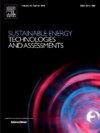Energy and economic implications of photovoltaic curtailment: current status and future scenarios
IF 7
2区 工程技术
Q1 ENERGY & FUELS
Sustainable Energy Technologies and Assessments
Pub Date : 2025-06-26
DOI:10.1016/j.seta.2025.104414
引用次数: 0
Abstract
As photovoltaic (PV) capacity grows, electricity grids are increasingly relying on curtailment to manage variability. Curtailments limit the amount of PV energy accepted by the grid, reducing revenues for PV operators, especially in high-penetration markets like Spain. However, their magnitude and economic impact have not yet been assessed at the national level. This study quantifies the energy and economic consequences of PV curtailment in Spain using real electricity production, curtailment and price data from October 2022 to September 2024. A techno-economic model is applied to calculate the impact of curtailment on the levelized cost of electricity (LCOE) and net present value (NPV) and to assess the viability of batteries. Results show that, over the investigated period, 2.5 % of PV-generated energy was curtailed without compensation, leading to a loss of €146,400 per day, an increase in LCOE by 0.10 €cent/kWh (+2.5 %) and a decrease in NPV of €27.1/kW (−7.7 %). Batteries sized at 0.2 kWh/kW could recover up to 80 % of curtailed energy, with an economically justifiable CAPEX of up to €47/kW. Additionally, each 1 % increase in curtailments would raise LCOE by 1.69 % and reduce NPV by 2.96 %. These findings highlight curtailment’s economic impact and the viability of batteries as mitigation.

光伏弃电对能源和经济的影响:现状和未来情景
随着光伏发电(PV)容量的增长,电网越来越依赖弃风发电来控制变异性。限电限制了电网接受的光伏能源数量,减少了光伏运营商的收入,特别是在西班牙这样的高渗透率市场。然而,它们的规模和经济影响尚未在国家一级得到评估。本研究使用2022年10月至2024年9月的实际电力生产、弃电和价格数据,量化了西班牙光伏弃电的能源和经济后果。采用技术经济模型计算弃电对平准化电力成本(LCOE)和净现值(NPV)的影响,并评估电池的可行性。结果表明,在调查期间,2.5%的光伏发电在没有补偿的情况下被削减,导致每天损失146,400欧元,LCOE增加0.10欧元/千瓦时(+ 2.5%),净现值减少27.1欧元/千瓦时(- 7.7%)。0.2 kWh/kW的电池可以回收80%的削减能源,经济上合理的资本支出高达47欧元/kW。此外,弃电每增加1%,LCOE将提高1.69%,净现值将降低2.96%。这些发现强调了弃电的经济影响和电池作为缓解措施的可行性。
本文章由计算机程序翻译,如有差异,请以英文原文为准。
求助全文
约1分钟内获得全文
求助全文
来源期刊

Sustainable Energy Technologies and Assessments
Energy-Renewable Energy, Sustainability and the Environment
CiteScore
12.70
自引率
12.50%
发文量
1091
期刊介绍:
Encouraging a transition to a sustainable energy future is imperative for our world. Technologies that enable this shift in various sectors like transportation, heating, and power systems are of utmost importance. Sustainable Energy Technologies and Assessments welcomes papers focusing on a range of aspects and levels of technological advancements in energy generation and utilization. The aim is to reduce the negative environmental impact associated with energy production and consumption, spanning from laboratory experiments to real-world applications in the commercial sector.
 求助内容:
求助内容: 应助结果提醒方式:
应助结果提醒方式:


